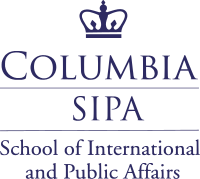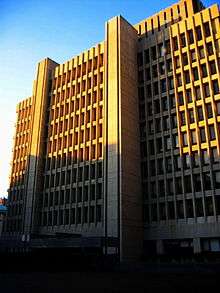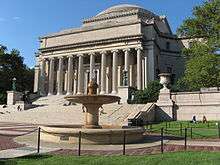School of International and Public Affairs, Columbia University
 | |
| Type |
Private Graduate school |
|---|---|
| Established | 1946 |
| Dean | Merit Janow |
| Location | New York City, New York, United States |
| Campus | Urban |
| Affiliations | APSIA |
| Website |
sipa |
The School of International and Public Affairs at Columbia University (also known as SIPA) is an international affairs and public policy school and one of Columbia's graduate and professional schools in Morningside Heights, Manhattan, New York City.
SIPA offers Master of International Affairs (MIA) and Master of Public Administration (MPA) degree programs in a range of fields, as well the Executive MPA and Ph.D. program in Sustainable Development.
SIPA offers a number of dual-degree programs with other schools of Columbia University and offers international dual degree programs with the London School of Economics and Political Science, Sciences Po, the Hertie School of Governance in Berlin, EAESP-FGV in São Paulo, the University of Tokyo and the Lee Kuan Yew School of Public Policy at the National University of Singapore through the Global Public Policy Network (GPPN).[1]
SIPA's alumni include former heads of state, business leaders, journalists, diplomats, and elected representatives.[2] Half of SIPA’s nearly 1,400 students are international, coming from over 100 countries. SIPA has more than 70 full-time faculty, many of which include the world's leading scholars on international relations.
History
Columbia University's School of International Affairs was founded in 1946, in the aftermath of World War II. Emphasizing practical training, the mission of the School was to foster understanding of regions of vital interest and to prepare diplomats, officials, and other professionals to meet the complexities of the postwar world. It originated in dynamic regional institutes that drew on Columbia's renowned faculties in history, economics, political science, linguistics, and other traditional fields. The School awarded a Master of International Affairs (MIA) degree.
By 1967, the School was home to eight regional institutes, covering nearly every part of the globe. It also contained the non-area-specific Institute of War and Peace Studies (now the Arnold A. Saltzman Institute of War and Peace Studies), founded in 1951 by university president Dwight D. Eisenhower.[3] Originally housed in a row of brownstones, the School moved into its own 15-story building in 1971.
To meet a growing demand for public service professionals, the school added a second degree, the Master of Public Administration, in 1977. In 1981, the program was renamed the Graduate Program in Public Policy and Administration and the School renamed the School of International and Public Affairs (SIPA).
In the early 1990s, SIPA began appointing its own faculty, supplementing the distinguished social and natural scientists and humanists with whom SIPA students studied around the University. Within 15 years, SIPA faculty were among the most prominent in their fields, including the one-time director of the U.S. census, a Nobel Laureate in Economics, a judge on the appellate body of the World Trade Organization, economic advisors in both the Bill Clinton and George H. W. Bush administrations, a former assistant secretary general of the United Nations, and many distinguished research scholars.
In 1992, with support from the World Bank, the Program in Economic Policy Management (PEPM) was established to provide mid-career finance professionals with the skills required for effective design and implementation of economic policy, emphasizing the problems of developing and transition economies. Students who complete PEPM’s requirements are awarded an MPA degree.
To accommodate the needs of working professionals who could not pursue full-time study, SIPA established the Executive MPA program in 1999 as part of the Picker Center for Executive Education. In 2001 the School introduced an MPA in Environmental Science and Policy (ESP), which condenses the two years into twelve consecutive months, without a reduction in requirements, and provides core courses in management and policy analysis with a concentration in environmental science and earth systems. The ESP MPA program is offered in cooperation with The Earth Institute and the Lamont-Doherty Earth Observatory. In fall 2004 SIPA inaugurated its first doctoral program, the interdisciplinary Ph.D. in Sustainable Development, which combines elements of a traditional graduate education in social science, particularly economics, with a significant training in the natural sciences.
Academics
International Dual Degree Programs
Through the Global Public Policy Network, SIPA offers a number of dual-degree programs with the University of Tokyo, the London School of Economics, the Institut d'Études Politiques de Paris (Sciences Po), the Hertie School of Governance in Berlin, and the Lee Kuan Yew School of Public Policy at the National University of Singapore.[4]
Concentrations and Specializations
In addition to fulfilling all core requirements, MIA and MPA students must also satisfy the requirements of both a policy concentration and a specialization. Students choose one of the following six concentrations: Economic and Political Development; Energy and Environment (with focus areas in Global Energy Management & Policy; Energy Resource Management; and Environmental Policy & Management); International Finance and Economic Policy (includes focus areas in international finance; international economic policy; and central banking); Human Rights and Humanitarian Policy; International Security Policy; or Urban and Social Policy.
Students choose a specialization in one of the following: Advanced Policy and Economic Analysis; International Organization and UN Studies; Technology, Media, and Communications; Management; or regional expertise (8 different regions/countries). Regional specializations are offered in the following areas: Africa, East Asia, East Central Europe, Europe, Latin America, The Middle East, Russia, South Asia, and the United States.
Rankings & Reputation
Foreign Policy ranked SIPA fifth in its 2018 ranking of "Top Master's Programs for Policy Career in International Relations".[5] In addition, SIPA was ranked first by U.S. News & World Report Best Graduates Schools 2018 world rankings for International Global Policy and Administration and fifth for Environmental Policy and Management.[6]
Centers
SIPA is home to five centers:[7]
- Center for Development Economics and Policy (CDEP): Supports microeconomic research to investigate the sources of poverty and to inform practical interventions to address them.
- Center on Global Energy Policy (CGEP): Provides independent, balanced, data-driven analysis to help policymakers navigate the complex world of energy.
- Center on Global Economic Governance (CGEG): Produces policy-oriented research on global economic governance.
- Center for International Conflict Resolution (CICR): Contributes to the resolution of international deadly conflict through research, education and practice.
- Saltzman Institute of War and Peace Studies (SIWPS): Founded in 1951 under the sponsorship of Dwight D. Eisenhower, during his tenure as president of Columbia University, SIWPS was created to promote understanding of the "disastrous consequences of war upon man's spiritual, intellectual, and material progress". The institute has become one of the leading research centers on international relations in the United States.

Publications
Journal of International Affairs was established in 1947 and is the oldest university-affiliated publication in the field of international relations; it is edited by SIPA students.
The Morningside Post is SIPA's student-founded, student-run multimedia news publication. Its content: student-written investigative news about SIPA and the SIPA community, plus world affairs analysis, opinion, and satire.
Conflict Resolution Journal is a dynamic and evolving web-based project founded by SIPA students
SIPA News is a biannual publication featuring articles by faculty, students, and alumni as well as news about the school
Notable alumni
- Madeleine Albright former United States Secretary of State
- Jose Ramos Horta (graduate student), President of East Timor (2007–); former Prime Minister; Nobel Laureate
- Salim Ahmed Salim, Prime Minister of Tanzania, Secretary General of the Organization of African Unity, President of the United Nations General Assembly
- Joseph Kofi Adda, Member of Ghanaian Parliament for Navrongo Central and Ghanaian Minister for Energy
- Ibrahim Agboola Gambari, Minister of External Affairs of Nigeria and UN Under-Secretary-General for Political Affairs
- David Kay, Chief UN weapons inspector and head of Iraq Survey Group
- George Tenet, Former Director of the Central Intelligence Agency
- Howard Warren Buffett, former policy advisor, Executive Office of the President of the United States (for Barack Obama), executive director of the Howard G. Buffett Foundation
- William Clark, Jr., former U.S. Ambassador to India
- Bill de Blasio, Mayor of New York City and former Public Advocate
- Ina Drew, former Chief Investment Officer for J.P. Morgan; forced to resign after JPM suffered a trading loss of $2 billion in April/May 2012
- Pamela Druckerman, writer and freelance journalist
- Yifei Fan, newly appointed deputy governor of the People's Bank of China
- Daniel Fried, Assistant U.S. Secretary of State for European and Eurasian Affairs
- Steven Fulop, Mayor of Jersey City, New Jersey
- Eric Garcetti, Mayor of Los Angeles
- Nellie Gorbea, Secretary of State of Rhode Island
- Victor Gotbaum, Head of DC37, the largest municipal union in New York City
- Patricia M. Haslach, former U.S. Ambassador to Laos
- Glenn Kessler (journalist), Washington Post reporter and author
- Shinjirō Koizumi, son of former Japanese Prime Minister Junichiro Koizumi; secretary of the Japanese National Diet
- Stephen Krasner, Director for Policy Planning at the U.S. Department of State and Professor of International Relations at Stanford University
- Edward Luck, United Nations expert and SIPA professor
- Gunnar Lund, Ambassador of Sweden to France (2008–present); formerly to the United States
- Jim Nicholson, former U.S. Secretary of Veterans Affairs
- Michael Oren, Israeli ambassador to the United States
- Robert D. Reischauer, Director of the U.S. Congressional Budget Office
- Curtis Roosevelt, international civil servant and professor
- James Rubin, Assistant Secretary of State for Public Affairs and Chief Spokesman for the State Department (1997–May 2000)
- Elizabeth Rossiello, Founder and CEO of BitPesa
- Vuslat Doğan Sabancı, billionaire Turkish businesswoman and chairwoman of Hürriyet
- William E. Schaufele, Jr., former U.S. representative, UN Security Council; former Ambassador to Poland
- Andrew J. Shapiro 1995, Assistant Secretary of State for Political-Military Affairs (2009–)
- Claire Shipman, ABC News correspondent
- Sichan Siv, former U.S. Deputy Secretary of State, former U.S. Ambassador to the United Nations Economic and Social Council (ECOSOC)
- Richard Mills Smith, CEO of Newsweek
- Frank Snepp, journalist and former CIA analyst
- Joan E. Spero, President of the Doris Duke Charitable Foundation and Undersecretary of State for Economic, Business, and Agricultural Affairs
- Katie Stanton, head of international strategy, Twitter
- Jens Ulltveit-Moe, Founder and CEO of Umoe AS
- Alexander Vershbow, Deputy Secretary General of NATO and former Assistant Secretary of Defense for International Security Affairs
- Ross Wilson, U.S. Ambassador to Turkey
- Brian Wynter, Governor of the Bank of Jamaica
- Donald Yamamoto, Principal Deputy Assistant Secretary of State and former ambassador to Ethiopia
- Peter Zalmayev, human rights activist and Director of the Eurasia Democracy Initiative
Notable faculty
- Chris Blattman, development economist, blogger
- Jagdish Bhagwati, trade economist
- Richard K. Betts, prominent political scientist and director of the Saltzman Institute of War and Peace Studies
- J. Bowyer Bell, historian, artist, and art critic
- Akeel Bilgrami, philosopher of language and of mind
- Guillermo Calvo, economist for macroeconomics and monetary economics, famous for Calvo (staggered) contracts
- David Dinkins, first African American mayor of New York City
- Mamadou Diouf, historian
- Michael W. Doyle, the theorist of the liberal “democratic peace”
- Albert Fishlow, noted expert on Brazil and former Deputy Assistant Secretary of State for Inter-American Affairs
- Howard Steven Friedman, Health Economist and Statistician at the United Nations
- Merit Janow, the only North American member of the WTO appellate body; former Deputy Assistant U.S. Trade Representative for Japan and China (1990–1993)
- Robert Jervis, one of the most influential international relations scholars, expert on foreign policy analysis and political psychology
- Rashid Khalidi, historian and former director of SIPA's Middle East Institute
- Kenneth Lipper, former deputy mayor of New York City, financier, novelist, and screenwriter
- Mark M. Lowenthal, former Assistant Director of Central Intelligence for Analysis and Production and Deputy Assistant Secretary of State for Intelligence Research
- Edward Luck, expert on the United Nations
- William H. Luers, retired career diplomat and museum executive
- Mahmood Mamdani, leading Africa scholar
- Jack F. Matlock, Jr., former U.S. Ambassador to the Soviet Union
- José Antonio Ocampo, former UN Under-Secretary-General for Economic and Social Affairs
- Mary Robinson, the first female President of the Republic of Ireland; United Nations High Commissioner for Human Rights
- Arvind Panagariya, professor of economics
- Kenneth Prewitt, political scientist and former director of the United States Census Bureau
- David Rothkopf, Chairman and CEO of The Rothkopf Group, and Garten Rothkopf, and former Deputy Undersecretary of Commerce for International Trade
- Jeffrey Sachs, chief economic advisor to many governments, former Director of the UN Millennium Project, Special Advisor to United Nations Secretary-General on the Millennium Development Goals
- Giovanni Sartori, Albert Schweitzer Professor Emeritus in the Humanities at Columbia University
- Stephen Sestanovich, former Ambassador-at-large and Special Advisor to the Secretary of State on the New Independent States (NIS)
- Gary Sick, Iran expert and three-time member of the National Security Council
- David Siegel - Adjunct Professor of Entrepreneurial, Organizational and Strategic Management ; CEO of Investopedia
- David C. Stark, professor of sociology
- Alfred Stepan, professor of government
- Joseph Stiglitz, Nobel Prize-winning former Senior Vice President and Chief Economist of the World Bank and former chair of the President's Council of Economic Advisors
- Kenneth Waltz, one of the most influential international relations scholars. He is one of the founders of neorealism, or structural realism, in international relations theory.
Notable former faculty
- Ernst Jaeckh (1875–1959), German-born orientalist and founder of the Middle East Institute
- Lisa Anderson, former dean of SIPA and a leading expert on the Middle East; former president of the American University in Cairo
- Zbigniew Brzezinski, National Security Advisor under U.S. President Jimmy Carter
- Robert C. Lieberman, former interim dean of SIPA and provost of the Johns Hopkins University
- John Ruggie, former dean of SIPA; former Assistant Secretary-General and chief advisor for strategic planning to United Nations Secretary-General Kofi Annan. He continues to serve as the UN Secretary General's Special Representative for Business and Human Rights
- Zalmay Khalilzad, former United States Ambassador to the United Nations
- Amina J. Mohammed, Deputy-Secretary-General of the United Nations and former Ministry of Environment of Nigeria
Notable former international fellows
- Michael Armacost, Diplomat, Deputy Secretary of State, President of Brookings Institution
- Bonnie Erbe, Host of the PBS television show To the Contrary
- Harold Varmus, Nobel Prize Winner, Head of National Institute of Health
- Jim Hightower, Progressive Activist
- Richard M. Smith, Chairman and Editor-in-Chief of Newsweek
- Frederick Kempe, President, Atlantic Council of the United States
References
- ↑ "Dual Degree Programs". Columbia | SIPA. Retrieved 2016-05-30.
- ↑ Bradshaw, Della. "Meet the dean: Merit Janow, Columbia Sipa". Financial Times. ISSN 0307-1766. Retrieved 2015-09-02.
- ↑ "Columbia Founds War-Peace Study; Heads New Institute". The New York Times. 1951-12-10. ISSN 0362-4331. Retrieved 2016-05-30.
- ↑ "SIPA and the World". Columbia | SIPA. Retrieved 2016-05-30.
- ↑ Maliniak, Daniel; Peterson, Susan; Powers, Ryan; Tierney, Michael J. (2015-02-03). "The Best International Relations Schools in the World". Foreign Policy. Retrieved 2018-03-26.
- ↑ "Best International Politics Programs | Top Political Science Schools". US News Best Graduate Schools. Retrieved 2018-03-26.
- ↑ "SIPA Centers". Columbia | SIPA. Retrieved 2015-09-02.
External links
- Columbia University School of International and Public Affairs
- Master of Public Administration in Environmental Science and Policy
- Journal of International Affairs
- Conflict Resolution Journal
- The Harriman Institute
- The Morningside Post
- SIPA News
- Global Public Policy Network
- International Fellows Program
Coordinates: 40°48′27″N 73°57′35″W / 40.807527°N 73.959682°W
